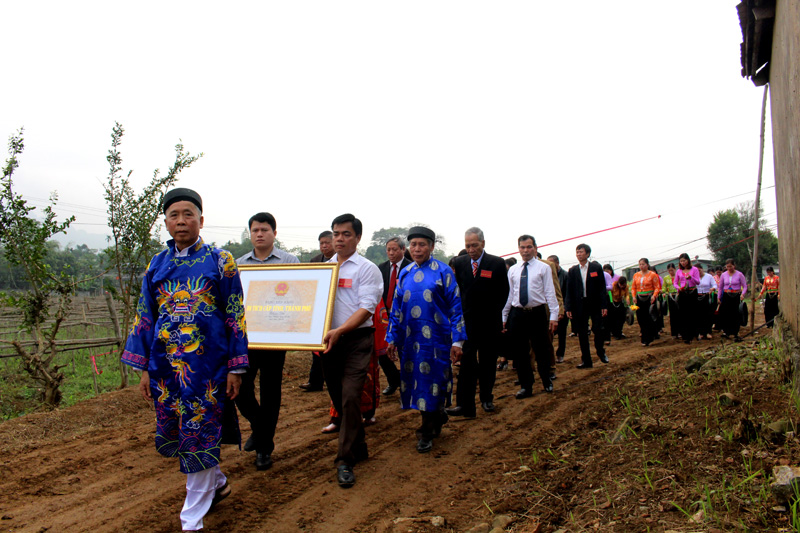



The people of Nam Thuong commune (Kim Boi) are organizing the procession by ranking the historical and cultural relics of the provincial pagoda.
Mr. Nguyen Thanh Ha, the Head of District’s Department of Culture and Information, says that now there is one national-level archaeological relic, that is the ancient tomb of Dong Thech (Vinh Dong commune). There are 3 provincial-level historical and cultural relics including Chieng communal house (Vinh Dong commune), Boi pagoda (Nam Thuong commune), Ba Be communal house (Hung Son commune). There are two revolutionary historical relics at the provincial level including Lap communal house (Kim Lap commune), the venue for the First Provincial Party Congress and the revolutionary relic that Uncle Ho paid a visit to, that is the Party Committee of Kim Boi district (Bo town).
Recognizing the importance of preserving and promoting the value of the relics, the Department of Culture and Information of the district has advised the People's Committee of the district to promulgate regulations on management, protection and promotion of the values of cultural and historical relics and the beauty spots in the district. The Management Boards of relics at district level and in communes having relics have been established. The Management Boards of the relics at the commune and district level has well performed the task of managing, protecting and organizing the rituals taking place at the relics. In addition, every year the district reviews and takes the inventory to detect the relics that are degraded so that they can to coordinate with the Department of Culture, Sports and Tourism to have a plan for repair and upgrade.
In recent years, using the State budget and other socialization sources, the district has repaired, upgraded and renovated a number of relics such as rebuilding Lap Communal House (Kim Lap commune), renovating and repairing the guesthouse of the District’s Party Committee into the Traditional Revolutionary House which Uncle Ho paid a visit to Kim Boi District Party Committee, restoring the objects Uncle Ho used when he stayed and worked in the District’s Party Committee including tables, chairs, beds, wardrobes, cupboards ... Currently, the artifacts have been completely restored and displayed at the Traditional House of Relics so that the local people and visitors can see them.
The conservation and promotion of the relics' value are also attached to keeping the traditional festivals by the Party Committee and the Government of Kim Boi district to attract tourists to visit and learn about the value of the relics. Each relic is associated with a legend, a traditional festival in the homeland of Muong Dong. The festivals are usually held at the beginning of the spring of a new year, or on holiday, having attracted a large number of people in the commune and other localities to attend. The organization of the festivals of the communal house, the temples, the pagodas and the relics partly meets the spiritual needs of the people, the need of inheriting and promoting the cultural quintessences left by the ancestors, contributing to preserving and promoting the Vietnamese culture imbued with the national identity.
The district is inviting investors to take part in building the spiritual tourism areas such as Vinh Dong pagoda, the area of Dong Thech ancient tomb and so on, combining setting the tours and routes connecting with the tourism areas and destinations in the area to attract tourists to visit and experience. At the same time, promoting and introducing the historical and cultural values, the potentials and strengths of the historical and cultural relics and the beauty spots have been strengthened in order to preserve and promote the values of these historical and cultural relics.